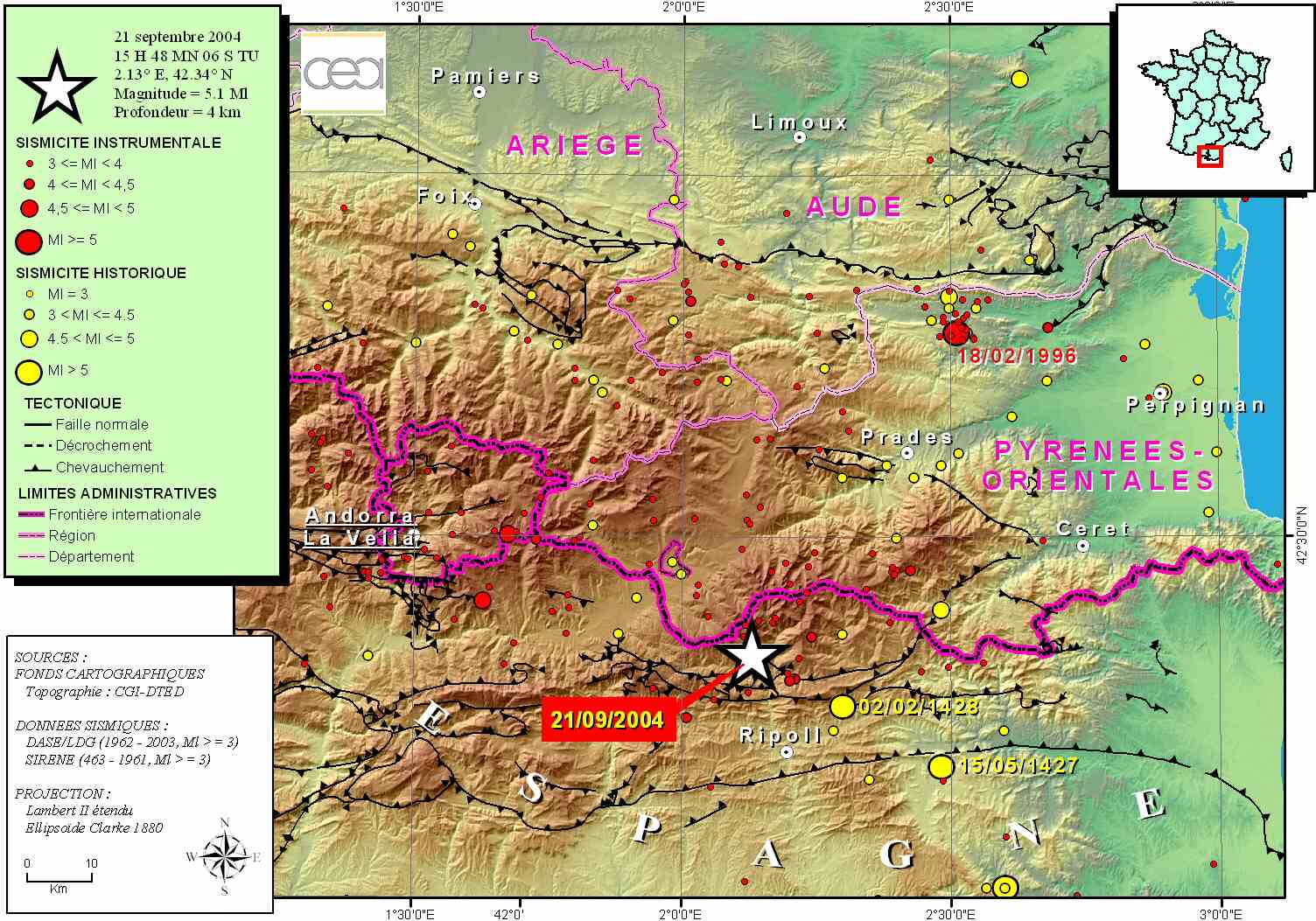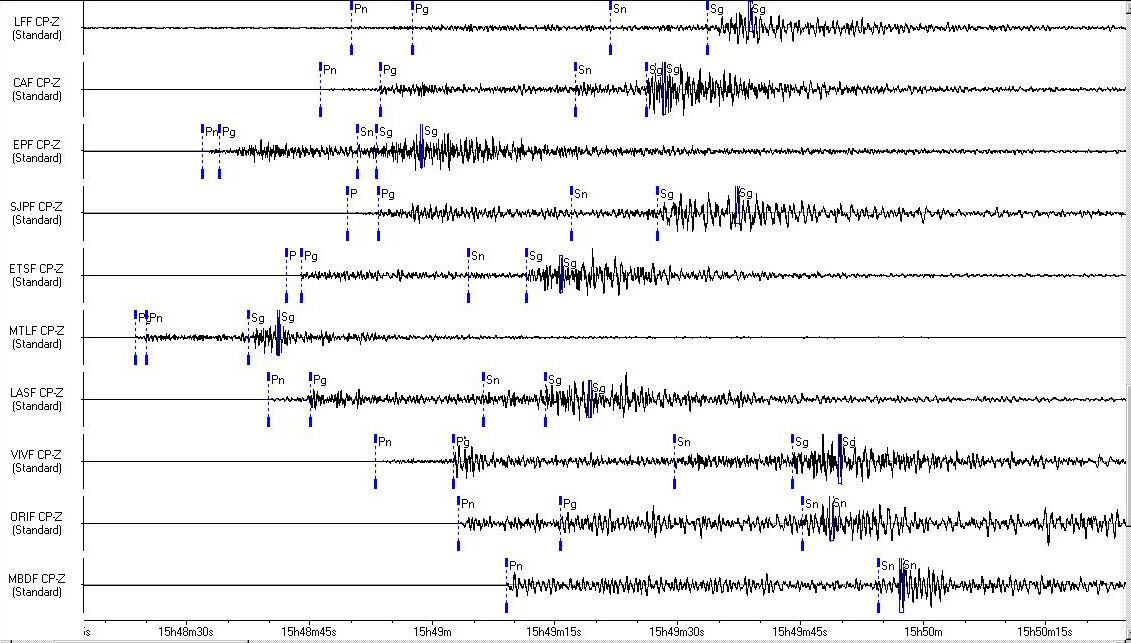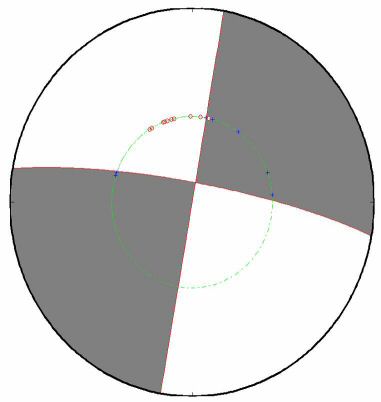
 |
RIPOLL EARTHQUAKE (SPANISH PYRENEES) September 21, 2004
|
 Description of the event Description of the event
On September 21, 2004 at 3:48:06 pm (UT) (i.e. 5:48:06 pm local time), an earthquake of local magnitude ML = 5.1 occurred in the eastern Pyrenees, about 11 km north-west of Ripoll (Spain) near the French border (about 20 km south of Prades), at latitude 42.34 N and longitude 2.13 E (Figure 1). Given its magnitude, this event was recorded on all the stations of the CEA-DASE seismic network (Figure 2).
This event was followed by about thirty aftershocks in 48 hours. The largest ones reached magnitude ML 3.

Figure 1: Location of the event of September 21, 2004 at 3:48 pm (UT) (white star) and of the instrumental and historical seismicity recorded in the LDG database (red dots).

Figure 2: Seismic signals recorded during the September 21, 2004 earthquake.
The main event triggered an alert on the CEA-DASE seismic monitoring network which was quickly sent to the Civil Defense Office and the relevant authorities by the duty seismologist. This event caused minor damage in Catalonia, close to the epicenter. It was felt all over Catalonia and in France as far as Sète.
Following a detailed analysis of the main earthquake, the number of seismic stations used was increased (including Spanish stations) and the precise location was determined and the magnitude estimated.
The following chart includes the characteristics of the main events that occurred within 48 hours of the main earthquake.
| Main event |
Date |
Time(UT) |
Latitude (°) |
Longitude (°) |
Magnitude (ML) |
21/09/2004 |
03:48:06 PM |
42.34 N |
2.13 E |
5.06 |
| |
| Aftershocks |
21/09/2004 |
03:52:00 PM |
42.37 N |
2.13 E |
3.20 |
22/09/2004 |
00:47:04 AM |
42.31 N |
2.18 E |
3.02 |
23/09/2004 |
09:50:22 AM |
42.5 N |
2.3 E |
3.5 |
23/09/2004 |
09:58:00 AM |
41.8 N |
2.1 E |
4.0 |
 Seismotectonic context Seismotectonic context
The earthquake of September 21, 2004 occurred in an area of moderate seismicity (Figure 1), if compared with that of the western Pyrenees (Béarn, Bigorre). This area is nevertheless periodically characterized by major earthquakes likely to cause widespread destruction.
Throughout history, the largest earthquakes recorded in the area are located to the south-east of the Pyrenees with an epicentral intensity of IX (MSK). These are the events of May 15, 1427 and of February 2, 1428 in northern Catalonia (Olot and Puigcerdà earthquakes). Many studies were conducted on these earthquakes and the faults in this part of the Pyrenees in order to determine the active structures that could be linked to these events. They suggest, for both medieval earthquakes, either an extension along the normal Tech and Têt faults oriented ENE-WSW, or a compression on the reverse fault of Vallfogona oriented E-W for the earthquake of 1428, and a movement on normal faults oriented NNW-SSE for the earthquake of 1427.
The focal mechanisms of recent earthquakes show, as far as the Pyrenees mountain range is concerned, a strong strike-slip component in the majority of cases, associated with either a reverse or a normal vertical component. To the east of the range, the very well-constrained focal mechanism of the Saint Paul de Fenouillet earthquake (1996, ML 5.6) is a left-lateral strike-slip mechanism along a subvertical EW fault plane, with a small normal component.
This series of observations indicates that northern Catalonia is located in a tectonically complex area that is subject to moderate compression (a few mm per year) linked to convergence of the Iberian and Eurasian plates. This results in reactivation of E-W faults (such as the North-Pyrenean Fault) and ENE-WSW faults (Têt Fault). The event of September 21, 2004 is characteristic of this tectonic environment. Given its magnitude, it is one of the most significant events of this area.
 Preliminary analysis of the source of the September 21, 2004 earthquake Preliminary analysis of the source of the September 21, 2004 earthquake
The focal mechanism of the September 21, 2004 earthquake (Figure 3), obtained from the first movements measured on the CEA-DASE stations, indicates a strike-slip fault with subvertical nodal planes as being the source. This result, which requires further investigation, is largely compatible with the seismotectonic environment described above. The modeling of the recordings of the CEA-DASE long-period sensors based on this focal mechanism produces waveforms that are compatible with the real ground motion. The seismic moment calculated for this event is 3x1015 N.m

Figure 3: Focal mechanism of the September 21, 2004 earthquake obtained from the analysis of the first motion measured on the CEA-DASE stations.
|